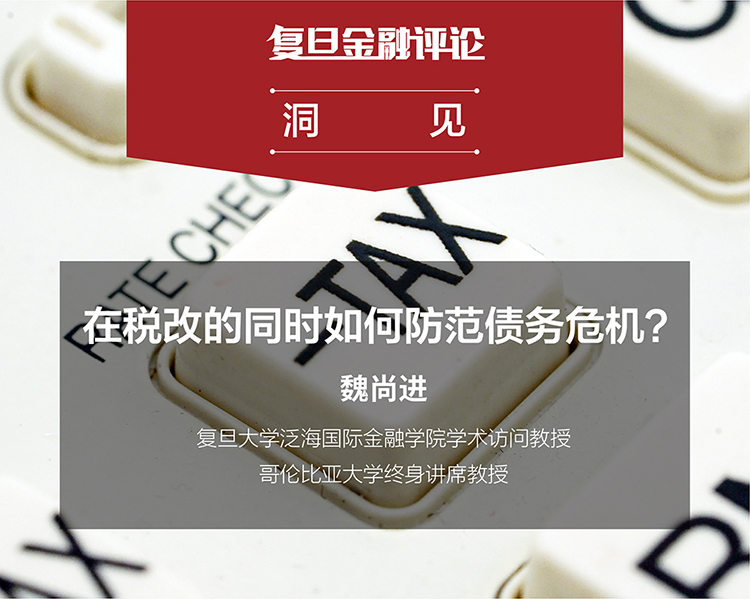在税改的同时如何防范债务危机?

导 语
减税政策是应对经济下行压力的有力一招,但也会增加未来债务危机的风险。为了避免因政府债务庞大招致的经济危机,我们可以采取哪些政策动作?
· 明确增值税减税政策的暂时性
· 扩大与提高排放税和污染税
· 提收国企积累分红与未分配利润
· 缩减政府规模
从2019年4月起,中国把养老保险的企业缴费率比例从16%~20%(有地区性差异)削减至16%,并将适用于大多数工业企业的增值税税率从16%降低至13%。这是在1月份宣布降低公司所得税基础上的又一轮减税政策。这些政策措施有助于应对经济下行的压力,不过同时也会增加未来债务危机的风险。
China has recently slashed the employer contribution rate to the social-security fund from 16-20% (with some variations across regions) to 16%, and cut the value-added tax (VAT) rate from 16% to 13% (for most enterprises). This is on top of a previously announced reduction in the corporate income-tax charged on the first CN¥3 million ($447,000) of taxable income. These policy moves are timely and useful in combating the downward pressure on economic growth, but they also raise the risk of a future debt crisis.
需要指出的是,政府财政收入的损失与税率的下降并不成比例,因为政府还可以通过强化执法来减少逃税,部分对冲掉税率的下降。尽管如此,政府仍然预期这次税改“组合拳”将大幅降低财政收入,仅在今年就减收近2万亿人民币,约占GDP的2.1%。这一政策组合在中期内可能将中央政府财政赤字的GDP占比从2.8%提升至5%,并可能将中央政府负债的GDP占比从47%推高至70%。如果再加上为填补社保体系资金缺口而负担的隐性债务,以及体量巨大的广义的地方政府债务,整体公共部门的债务规模会扩大,其GDP占比可能在数年后超过150%。
The loss of government revenue will not be entirely proportional to these rate reductions as the government can also tighten enforcement to reduce tax evasion. Still, the government expects the tax reform package to lead to a substantial reduction in revenue by some CN¥2 trillion, or about 2.1% of GDP, this year alone. The policy package would likely raise the central government’s fiscal deficit from 2.8% of GDP to about 5%, and increase central-government debt from about 47% of GDP to perhaps 70% over the medium term. Add to that the liabilities implicit in closing the funding gap in the social security system, as well as massive local-government debts, and overall public debt could grow much larger, potentially exceeding 150% of GDP in a few years.

国际经验表明,庞大而不断增长的政府债务难以持续,并极有可能导致重大经济危机。为了避免这样的后果,我建议可以考虑以下五方面的政策动作。
International experience from developing countries shows that a large and growing government debt is unsustainable and often leads to a major economic crisis down the road. To avoid such an outcome, China can consider five additional reforms.
第一,政府可以把增值税降低明确为一项暂时举措,比如宣布在2021年恢复2018年的税率(如果经济增长届时仍低于潜在增长率,减税期可以延长)。暂时减税不仅能让政府债务的长期总额承受更小的压力,它对经济的刺激作用还大于同样百分比的永久性减税,因为它更能激励家庭和企业尽早尽快地花钱和投资。
First, they should make the VAT reduction temporary, announcing that the 2018 rate will be restored in 2021 (with a possible extension, if the economy is still not meeting its growth potential). A temporary cut would not only put less pressure on the long-run value of the government debt; it would actually give a more powerful boost to growth than a permanent cut of the same percentage because households and firms would have incentive to spend and invest sooner.
在此需要指出的是,养老保险企业缴费率可以固定在16%,甚至可以考虑进一步下调至15%,不需要在两三年后回到2018年的水平。这是因为中国2018年的养老保险费率不仅高于大多数的发展中国家,也高于大多数的发达国家,严重影响企业的国际竞争力,从而间接负面影响民众的就业机会。另外,政府主导的养老保险其实质是强制储蓄,对美国、菲律宾这类居民储蓄率偏低的国家非常重要;而对中国这样的居民储蓄率很高的国家必要性不强。养老保险费率下调,会同时影响政府今后有关养老保险的支出与收入,所以对政府的总债务影响不大。
It should be pointed out that the reduction in the employer contribution rate to the social-security fund can be made permanent, and the contribution rate may even be further reduced to 15%. There is no reason to return to the level in 2018. China’s social security tax rate in 2018 was higher than not only most developing countries, but also most developed countries. By seriously undermining the international competitiveness of enterprises, it has a negative impact on job opportunities. It is important to note that the nature of a country’s social security system is a compulsory saving scheme, which is very important for countries with low savings rates, such as the United States and the Philippines. It is less crucial to impose a compulsory saving scheme in countries such as China when the households’ voluntary savings rate is already high. Because a reduction in the social security contribution rate will affect both the government’s future expenditures on pension payout and revenues, it will not have a significant impact on the government’s total debt in the long run.

第二,中国应该用新税种替代针对温室气体排放和污染的行政限制措施。由于从每年增量的角度来看中国是全世界最大的污染国和二氧化碳的排放国(以累计排放量计算,美国仍是全球最大的排放国),这些新税种的覆盖面会很广。现在公众对于环境保护政策的需求也日益强烈,扩大与提高排放税、污染税也符合公众追求高质量生活的愿望。
Second, China should replace administrative restrictions on greenhouse gas emissions and other pollution with new taxes. The scope for doing so is big as China is the world’s largest polluter and CO2 emitter, on an annual basis. (In cumulative emissions, the United States remains in the lead.) And public demands for environmentally friendly policies are growing stronger.
尽管中国针对某些污染物建立了适度的排放权交易机制,但在实践中大部分的管控还是以针对特定企业的特定活动的行政限制来实现。虽然这些行政限制和税一样通过增加企业的排放成本来降低排放,但却并不能为政府带来收入。这些限制还会造成相似行业生产者在边际生产成本上的差别,从而降低经济的总体效率。
While China has a modest tradable-permit program for certain pollutants, most of the control in practice takes the form of administrative restrictions targeting certain activities by certain firms. While such restrictions reduce emissions by raising costs of emission for firms, as a tax would, they generate no revenue for the government. They can also undermine efficiency, by creating disparities in marginal production costs among producers in similar industries.
更好的办法是用排放税和污染税来替代大部分甚至全部的行政限制(由于有些污染并不一定是温室气体的排放,所以这两个是不同的税种),并扩大覆盖到目前尚未受到行政限制的排放行为。与此同时,也应大力发展排放交易机制,包括通过降低企业必须付费的门槛和取消某些行业或企业不受排放权限制的豁免权。这些行动不仅能强化财政可持续性(新增财政收入每年可能达到GDP的2%~3%),还能提升资源的总体分配效率。
A better approach would replace most or all administrative restrictions with taxes on emissions and pollution – the two are not the same as some pollution does not involve greenhouse gas emission – and broaden the coverage to other offending activities not currently restricted. This includes ramping up the tradable-permit program by lowering the threshold beyond which firms have to pay and eliminate exemptions from permits by firms or industries. Such actions would not only boost fiscal sustainability – the additional revenues could total 2-3% of GDP – but also improve the efficiency of overall resource allocation.

第三,部分国有企业集团积累了大量分红与未分配利润,而它们的投资效率并不一定很高。国家作为这些企业集团的大股东,可以把这些积累的分红与未分配利润收到财政统一支配。这样一方面可以降低政府的债务总量,另一方面可以提高总体投资效率。这个政策动作在执行时的一个关键点是:不能一刀切——要区别那些投资机会还很充分、投资回报率高于全国平均水平的国企,与那些投资回报率比较勉强的国企。对那些效率持续较低而又处于竞争性行业的国企,也可以考虑将其卖给更有效率与创新能力的民企,从而为国库带来更多收入。
Third, some parent companies of state-owned enterprise groups have accumulated a large sum of dividends and undistributed profits, while they may not have much profitable investment opportunity. Since the State is the owner of these SOE conglomerates, it can demand to transfer these undistributed profits and dividends to the state coffer. This will not only help to reduce the government debt but also potentially improve the overall investment efficiency of the economy. To implement this policy, it is important not to adopt a one-size-fits-all approach. Instead, it is useful to distinguish between SOE groups that have high-return investment projects and others that have low efficiency and low returns. Furthermore, for low-efficiency SOEs in competitive sectors, it may be worthwhile to sell off these firms to the more efficient and more innovative firms in the private sector and generate more revenue for the State.
第四,中国可以通过精简其庞大的行政层级来减少政府支出。过去的几十年,国际上很多大型公司在公司治理层面的一个创新点就是利用新的信息技术与管理技术逐步减少了从高管到一线员工的雇员层级,从而达到了减支增效。相比之下,中国政府从七十年前中华人民共和国建立以来就一直保持着从中央到省级、地级、县级、乡级的五级行政架构。这一庞大的行政体系雇佣着超过一千多万公务员和几乎差不多规模的非公务员编制人员。
Fourth, China can lower government spending (in the medium term) by streamlining its vast administrative hierarchy. In recent decades, many of the largest global companies have taken advantage of new technologies to reduce the number of employee layers, from top executives to factory workers, thereby reducing costs and boosting efficiency. China’s government, in comparison, has retained the same five-layer administrative structure – starting with the central government, and moving down through provinces, prefectures, counties, districts or cities – since the founding of the People’s Republic 70 years ago. This vast administrative apparatus employs over 14 million civil servants, and millions more who work for government agencies but do not use that classification.
中国已经是全球电子商务和数字支付的领导者,同时具备成为电子政务先锋的所有硬件基础设施。通过采用数字技术及其他信息与管理技术,中国可以削减一到两层行政体系层级,这样总体效率可能不降反升。这个改革不仅将会减少政府的总支出,符合政府简政放权的思路,还有助于减少腐败。
China is already a global leader in e-commerce and digital payment; it has all the physical infrastructure to become a leader in e-governance. Using digital technology and other Information and management technologies, China could eliminate one or two layers of its administrative apparatus. This would massively and permanently reduce overall government spending, while improving the delivery of government services. It will also help with reducing corruption.

有人担心政府裁员会加剧经济增长放缓。但缩编并不需要一蹴而就。可以设定一个结合退休和正常辞职的长期减员计划来渐进式地为政府“瘦身”。还可以通过一些激励措施鼓励公务员加入自动离职计划,支持其在其他行业再就业。如此一来,有可能在8年之内就使政府的规模缩小15%~20%,并大幅提升其行政效率。
One concern may be that downsizing government employment would exacerbate the effects of slowing economic growth. But the cuts need not be abrupt. A longer-term attrition plan could be put in place that takes advantage of retirement and normal resignations to reduce the overall size of the government over time. Additional voluntary separations can be induced by modest inducements to subside job searches. In this manner, the government could be made 15-20% smaller – and considerably more efficient – within, say, eight years.
第五,房地产税或者土地使用税的普遍开征也能增加政府收入,尤其是可以帮助地方政府平衡它们的收支,也可以帮助土地价格与房产价格向更合理的水平过渡。
Fifth, it is time to make a real estate tax and land use tax a part of the tax system. To reduce distortions and minimize corruption, such taxes should be simple, uniform, and with no exemptions. This can become a significant part of local government revenue and can help housing prices to transition to a level more compatible with economic fundamentals.
中国最新的减税政策是应对经济下行压力的有力一招。未来债务危机的风险应通过几项配套措施来化解——明确增值税减税政策的暂时性,扩大针对温室气体排放和其他污染的税收,行使作为国有企业集团大股东的权利,提收其积累的分红与部分未分配利润,普遍开征房产税,并逐步缩减政府规模。这些改革措施能使中国经济变得更高效而持续繁荣。
China’s latest tax cuts serve an important purpose: to combat downward pressure on economic growth. The risk of a future debt crisis should be addressed with a few complementary actions – making the VAT rate cut temporary, broadening taxes on greenhouse gas emissions and other pollutants, converting undistributed profits and dividends from those low-efficiency SOEs to government revenue, implementing a real estate tax, as well as streamlining the government. These reforms will contribute to more efficiency, greater fiscal sustainability, and longer lasting prosperity.